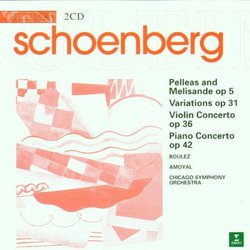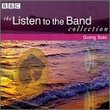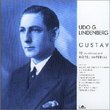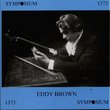| All Artists: Schoenberg, Cso, Boulez Title: Pelleas & Melisande / Variations / Violin Cto Members Wishing: 0 Total Copies: 0 Label: Elektra / Wea Release Date: 7/3/2001 Album Type: Original recording reissued Genre: Classical Styles: Forms & Genres, Concertos, Theatrical, Incidental & Program Music, Historical Periods, Modern, 20th, & 21st Century, Instruments, Keyboard, Strings, Symphonies Number of Discs: 2 SwapaCD Credits: 2 UPC: 639842424127 |
Search - Schoenberg, Cso, Boulez :: Pelleas & Melisande / Variations / Violin Cto
 | Schoenberg, Cso, Boulez Pelleas & Melisande / Variations / Violin Cto Genre: Classical
|
Larger Image |
CD DetailsSimilar CDs
|
CD ReviewsSchonberg from All Periods Christopher Forbes | Brooklyn,, NY | 08/07/2003 (5 out of 5 stars) "For some the idea of "bargain Schonberg" is an oxymoron. Getting this music for free would be ten cents too much. There is no composer who provokes more hostility than the Austrian, often hostility based on the mere mention of his name. But to those with a taste for this formidible and yet brilliant father of modernism, this disc is a wonderful addition to your collection, for in it you get an early Romantic masterpiece, two mature masterpieces of his high 12 tone period, and an enigmatic late work, all performed with clarity and depth. The tone poem Pelleas und Melisande is one of a number of works inspired by the Symbolist drama by Maeterlinck. Though this is a tone poem, it is the closest thing we have to a symphony by Schonberg. It is constructed in the one movement form the composer would use again in the 1st string quartet and the Chamber Symphony. This form essentially condenses the four traditional movements of the symphony into one movement, allowing the scherzo and slow movement to be created by developing material from the initial opening themes, and resolving it all in a varied recapitulation which resembles a traditional finale. Thus, though this is a tone poem, it is a poem more about the "spiritual states" of the characters in the play, rather than a straightforward musical telling of the story. The musical language itself is rather like Schonberg's earlier Verklarte Nacht. It is highly chromatic, almost reminiscent of Reger, though Schonberg has a better-developed sense of melody. But, though the chromaticism stretches the bonds of tonality they don't break, and the piece is resolutely centered on d minor, Schonberg's favorite tonal center even in his atonal works!With the Variations we reach one of the composers most impressive 12-tone pieces, written in the late 20s as the composer began to show real mastery of the style. This is the most unrelentingly atonal work in the collection and a stark contrast to the lush and beautiful Pelleas. The work is a true theme and variations. The theme enters after a short, harmonic introduction, played broadly in the strings. The rest of the work is a highly contrapuntal set of character variations, traversing a world of nightmare moods. The counterpoint is so well developed as to be almost overwhelming on first listening. Details in the subsidiary lines often draw focus from the primary melodic material and this can bewilder the novice to this style. However, with repeated close listening, the processes of the variations become evident and the remarkable unity of the work become obvious. This is truly one of the pinnacles of the Schonbergian oeuvre.The Violin Concerto was written almost 10 years later and is one of my favorite Schonberg works, one that I've loved since I first heard it on a PBS broadcast when I was 11. (Yes, there's a reason I call myself weird ears!) This work is to me, one of the most well crafted and intellectually precise violin concerti in the repertoire. The key to understanding this work is to listen carefully to the opening slow introduction. Between the rising chromatic scale in the violin and the later material as the instrument soars more lyrically, the material of the entire concerto can be heard. All other material is audibly derived from these motives. The rising chromatic motive dominates the first movement, while the inversion of the original tone row, which is characterized by a falling semitone, dominates the last movement. Careful listening starts to make sense out of the welter of motives in the counterpoint and the work achieves a remarkable unity. Plus, Schonberg the orchestrater is highly evident in the work, particularly in the astounding cadenza in the last movement for violin and percussion. The final work on the CD is the Piano Concerto, which to me is a more problematic work. Many things about this piece are amazing. It is set in Schonberg's cyclical one movement form, but unlike earlier one movement pieces, this is a looser structure and almost monothematic. Even with the monothematicism though the work confounds. The theme itself is not especially memorable and as a result, I tend to get lost in the listening. Perhaps more time will help me to unlock the work, which has definite beauties, not the least being that the piece, though 12 tone, is highly tonal and even resolves on a tonal chord, like much of Schonberg's American works. It is basically an attractive work even though it is enigmatic. Performances on this disc could not be better. Boulez, or all his youthful disdain of Schonberg, makes a marvelous interpreter of his work. He brings clarity to the composer's dense orchestration that is welcome indeed. Instead of the mud that some conductors make out of these works, we get a lush transparent sound and can revel in the composer's feel for orchestral color and the sheer beauty of instruments. Boulez can even wax romantic when needed, as in the version of Pelleas, which is full blooded and passionate. If his tendency in the later 12 tone works is to objectify them rather than play up the romantic elements still present in this music, it is probably for the best. Most romantic interpretations of this music end up tending toward the hysterical. Boulez brings a balance between the emotions of the Schonberg works and the intellect behind. Soloists Pierre Amoyal in the Violin Concerto and Peter Serkin in the Piano Concerto are both excellent. Particular kudos go to Amoyal, who tackles this difficult work with warmth and aplomb, avoiding for the most part, the ugly scraping that many violinists resort to when playing the piece. So, if you are interested in "pretty" music, go somewhere else. Even at his best, Schonberg is never pretty. But if you want really excellent readings of seminal works of early 20th century modernism you can't go wrong with this disc." A visionary Pelleas and a passionate Violin Concerto Sator | Sydney, Australia | 07/15/2005 (5 out of 5 stars) "This two CD collection presents rather disparate works from different periods in Schoenberg's career, each of which has its own appeal. The Pelleas und Melisande is a work that anyone who loves late 19th to early 20th century music should hear. If you like Wagner, Mahler or Strauss then you really must hear this. Even if the prospect of hearing the later twelve tone works is something you still find off-putting because even after 60 - 70 years they remain 'too modern', this CD set is nonetheless worth acquiring even just to hear this Pelleas. In fact I think this is probably the most convincing symphonic tone poem that has ever been composed. As a musical genre the tone poem is all too often a bit of a structureless hodge-podge but the quasi-sonata form symphonic structure here (I am following Berg's analysis) gives it a structural unity that far surpasses any other essay in this form. Boulez has a wonderful grasp of this work - vastly superior to any other I have yet to hear. He fully captures the world of the towering mysterious Medieval castle, the darkness of its dungeons, and the wonders of its surrounding forests in an astonishing performances that simply has to be heard to be believed. The work emerges as a totally convincing twentieth century masterpiece and the playing of the Chicago Symphony is just beyond all praise. The next work in this collection is the Variations for Orchestra, which was the first twelve tone work for orchestra ever written and which was premiered by the Berlin Philharmonic under Wilhelm Furtw?ngler in the 1930's. Quite contrary to the peculiarly distorted reputation that the composer has developed, this work is in fact thoroughly Brahmsian in its form and style. For a start the variations technique employed is the Brahmsian technique of what Schoenberg called 'developing variations' (see his wonderful essay entitled 'Brahms the Progressive'). Just as in Brahms' first major orchestra work, the St Anthony Chorale Variations, there are sections which are scherzo like and slow movement like. In fact most of the post-war avant garde has been utterly scathing of Schoenberg's blatant Romanticism - especially Boulez, who remains a poor advocate of this work, since he has never had a single good thing to say about it. If he thinks so little of it's 'Romantic degeneracy' why does he bother performing it at all I wonder? The tone row for the work also contains the notes B-A-C-h. Just before the recapitulation and right at the end of the work Schoenberg spells out these four notes as though standing on his chair and triumphantly shouting Bach's name out - a wonderful moment in twentieth century music. However, as much of a Boulez fan I am I must commend you to Rattle or if you can find it, Scherchen, who both bring out the wonderfully visionary aspects of this monumental work - especially Scherchen who is just overwhelming. The violin concerto is a work that sounds even more like Brahms. It receives good advocacy by Pierre Amoyal. This performance has always raised eyebrows for a being overtly Romantic in its style but in fact this is perfectly consistent with Schoenberg's musical thought. I quote Schoenberg himself: 'Why is music written at all? Is it not a romantic feeling which makes you listen to it? Why do you play the piano when you could show the same skill on a typewriter?' As for the piano concerto, I must once again point the listener elsewhere - this time to the partnership between Uchida and Boulez. That interpretation is even more Romantic but Schoenberg is a composer who saw himself as the heir of Brahms and Wagner. He is the epitomy of the ideal of the Romantic artist driven by his ideals to create something so astonishing that he is forever doomed to misunderstanding. So all in all this a great, if rather too diverse a collection of Schoenberg's music, but there are wonderful things here - especially the Pelleas, and for that and the recording of the Violin Concerto, I give it five stars." Four major Schoenberg works, two world-class orchestras R. Hutchinson | a world ruled by fossil fuels and fossil minds | 06/11/2010 (5 out of 5 stars) "Pierre Boulez leads the Chicago Symphony Orchestra and the London Symphony Orchestra in four major Schoenberg works on this 2-disc set. "Pelleas und Melisande, op. 5" (1903 -- 40'12) and "Variations for Orchestra, op. 31" (1926/8 -- 20'06) were recorded in 1991 with the CSO, while the "Violin Concerto, op. 36" (1936 -- 33'38) and "Piano Concerto" (1942 -- 21'03) were recorded in 1984 and 1985 with the LSO. This Erato set has been reissued again more recently by WEA in their Apex line.
"Pelleas und Melisande" is a symphonic poem, "after Maurice Maeterlinck." Schoenberg's first composition for orchestra, it is an accomplished work of its kind, a synthesis of Brahms and Wagner. This late Romantic music is not in the same league as Mahler's symphonies, but then Schoenberg was not to follow in the footsteps of his mentor and supporter. From the early Schoenberg we jump to the late Schoenberg, applying his 12-tone system to orchestral writing for the first time with the "Variations for Orchestra." Boulez and the CSO produce a most impressive feat here, transforming what I had thought of as a work more to be admired for its formal architecture than actually enjoyed, into a truly evocative journey. Slightly slower and more spacious and with a deeper bottom than the earlier Boulez recording with the BBC Symphony Orchestra, this is clearly the version to hear. The lifelong influence of Brahms is strong in this piece as Schoenberg pursues the classical variations form using his new language. The second disc, with the LSO, is not as impressive as the first -- the sound is a bit thin and remote -- but it affords a great opportunity to hear two of Schoenberg's late 12-tone works back to back. The "Violin Concerto" has long been considered to be a lesser work, and not often performed, until its spectacular revival by Hillary Hahn, Esa-Pekka Salonen and the Swedish Radio Symphony Orchestra with the Grammy-award winning recording of 2008. This earlier recording by Pierre Amoyal with Boulez and the LSO has a completely different personality than the acclaimed Hahn recording. Amoyal/LSO has a long sweep to it, and a tragic cast, while Hahn/SRSO is up close and detailed, more energetic and striving. Not only the violin but the orchestral detail is much richer in the more recent recording. It is clear why violin virtuoso afficionados were ecstatic about Hahn's performance, which is substantially faster than Amoyal's. But I find something profound in this earlier performance which I would not want to do without. It's like aerial photography in contrast to a close-up -- the big picture is more clear. And Amoyal brings an evocative tragic tone that while not as virtuosic as Hahn, is in some passages more moving. The "Piano Concerto" is here performed by Peter Serkin. While perfectly fine, I do not find the performance to be as compelling as the others I've heard. Maurizio Pollini's recording with Abbado and the Berlin Philharmonic features more athletic pianism, but the absolutely stunning recording by Mitsuko Uchida with Boulez and the Cleveland Orchestra is clearly the best of the three. As with the Hahn/Salonen "Violin Concerto," the detail is much greater in the Uchida/CO than in this Serkin/LSO recording, and much greater than in the Pollini/BPO as well. The dynamics are much greater too -- in this recording it's as if everything has been compressed. Boulez clearly outdid himself with the more recent recording from 2000. But still, this is an excellent compilation of orchestral Schoenberg, and particularly if you can find it for a bargain price, it is definitely worth hearing. Personally I am not that interested in the early Schoenberg and was attracted by the three late 12-tone works. But the combination works well. What is missing is the atonal period that came in-between, arguably featuring Schoenberg's most radical compositions. While his music is still rejected by many classical listeners, what comes across here is Schoenberg's respect for and continuity with the 19th century tradition. Clearly many of the world's best performers agree." |

 Track Listings (13) - Disc #1
Track Listings (13) - Disc #1



